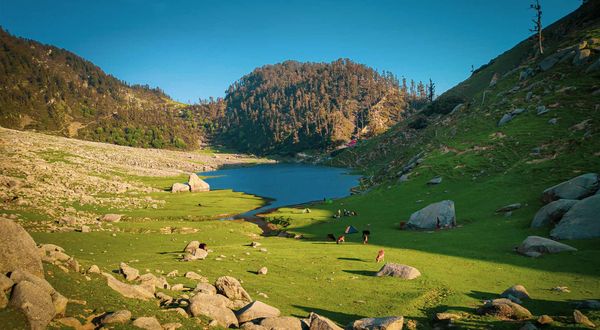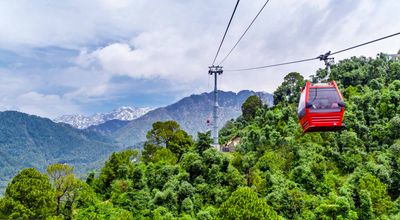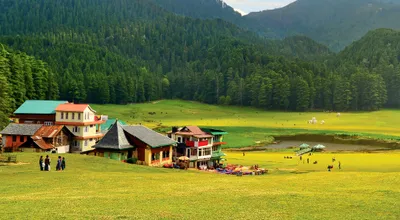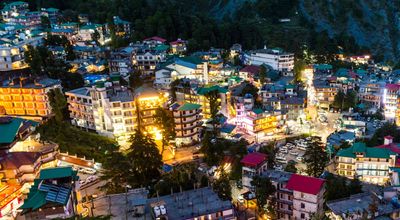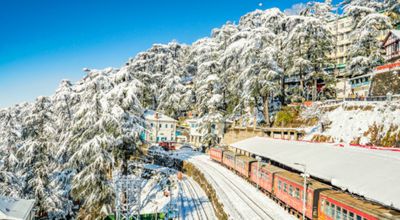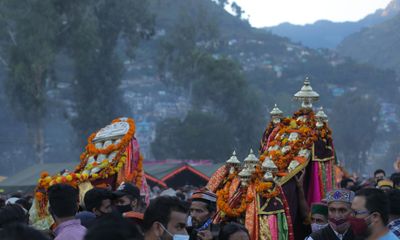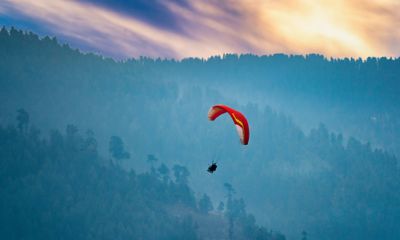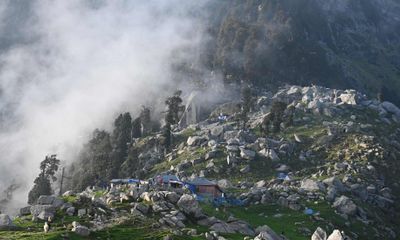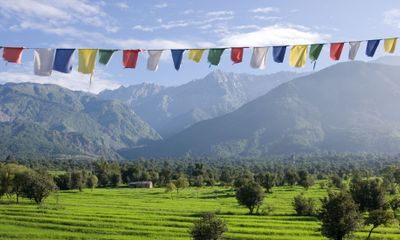Imagine a lake with such still water that the surrounding mountains reflect perfectly off its surface. Find this distinct wonder at Kareri Lake. Nestled in the Dhauladar Range of the Himalayas, this glacial lake attracts many hikers every year. If you're planning a trip to Kareri Lake, explore the steps necessary to make the trip a successful one.
Reaching the Starting Point
If you're already vacationing in Dharamshala, hire a taxi to take you to the trek meeting point at Kareri Village. Typically, this ride is only about 20 or 30 minutes long. For visitors traveling from farther areas, consider buses, trains or airplanes. In general, most major transportation choices stop in Dharamkot, which is a densely populated area. From here, you can easily find taxis to get you to the starting point.
If you take a bus to Dharamkot, verify that it's a government-sanctioned vehicle. Private buses often have delays. Ideally, you want to arrive at the trek meeting area in the early morning. Setting off on a late hike means you'll be hurried and potentially walking after dark.
Packing for the Trek
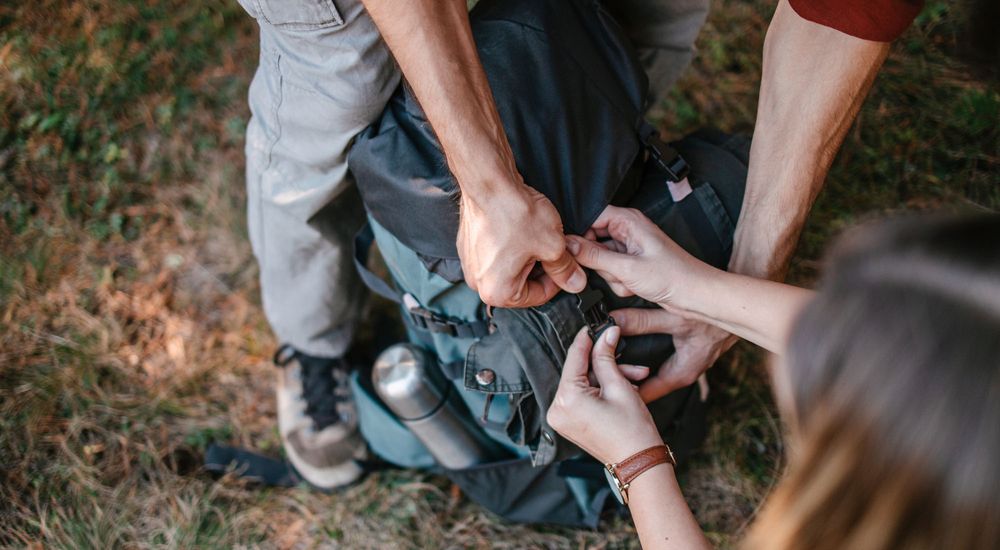
Bring a sturdy backpack for the trip. Ideally, it should be large enough to carry all your necessities, but lightweight enough for the long hike. At the bare minimum, pack these items, including:
- Extra t-shirts
- Extra pants
- Jacket
- Extra socks
- Toilet paper
- Plastic bags
- Warm hat
- Trekking pole
Wear hiking boots with a healthy tread. Although you may be visiting during moderate weather, the trail can become slippery at times. In addition, bring a first-aid kit for those possible scrapes and bruises.
At the lake, there are tent rental options. However, many visitors pack their own tents and sleeping bags. Alternatively, seek out the nearby gaddi huts for a unique, outdoor experience. Regardless of the chosen shelter, bring warm clothes so that the cool night is as comfortable as possible.
Detailing Your Two-Day Itinerary
Begin your adventure at base camp or Kareri Village. From here, the day's hike includes a gradual ascent into the forest dotting the foothills. Typically, the hike takes around 4 to 5 hours to complete. For the first few hours, you may encounter a few steep sections. By using your trekking pole, carefully maneuver up the stone steps that are often cut right into the land for easier walking.
Remember, you'll be moving through a pine forest, which means slippery conditions are possible. Ideally, take your time as you walk over the pine needles. Using a casual pace for safe hiking also allows you to gaze up at the trees and enjoy the scenery.
At times, the trail takes you out of the forest and onto an actual road. Additionally, you'll cross several bridges that span the stream. With varied terrain, proper hiking boots will mean the difference between a successful hike and an uncomfortable experience. Without a doubt, you'll need to cross over a few boulders as you move closer to your overnight destination called Reoti.
Next, you'll leave the forest and enjoy the open grasslands. With the mountains in the background, this area is popular for photographs and stopping for a break. Once you reach Reoti, it's time to set up camp for the night. As an added convenience for trekkers, Reoti offers hot meals, free-flowing stream water and camping rentals. Indeed, you can also purchase packaged meals at the small shop if your supplies run low. Tomorrow, you'll hike a short, 1.5 hours to Kareri Lake and back to Kareri Village to complete your trek.
Taking a Look at Trail Highlights
Initially, the trail offers a view of a dense forest complete with pine trees. Become a bird-watching expert here as you see red-billed blue magpies and black drongos frolicking in the canopy. Farther along, you'll also encounter redstarts, warblers, Himalayan griffon vultures and brown dippers.
A unique feature of this trek is the multiple shacks along the way. As makeshift rest stops, these shacks usually sell drinks and food to hungry hikers. Remarkably, they're carefully spaced out so that you can enjoy the land as a natural wonder, but with some basic resources close by. In total, there are around four shacks selling food and drinks along with gaddi huts used by locals for sheltering purposes.
Certainly, trail highlights also include the nallah or stream that you follow during the trek. As you walk, the water flow offers its relaxing sounds as you eventually find a small waterfall. Here, fill your water bottle at the falls, and take a short break. Of course, the stream and waterfall are both supported by Kareri Lake. In short, you know you're hiking in the right direction with the stream as your guide.
Lastly, be aware of local shepherds who herd the flocks in this region. If you're lucky, you might see them moving along the trail. Their presence should remind you of the humble lives lived under the mighty Himalayas.
Arriving at the Lake
Because you camp at Reoti, there's a short hike in the morning to reach Kareri Lake. By following the perimeter trail, arrive at the lake's edge. Because it's a glacial lake, Kareri has very cold water. Surprisingly, the lake's banks have a shallow shape. If you're adventurous, dip your toes into the lake. Although the Himalayas weren't formed by glaciers, this lake is a reminder of how natural processes create amazing landmarks in India.
In general, most visitors enjoy a view of the lake and surrounding mountains for a few hours in the morning. Afterward, hiking back to Reoti and eventually to Kareri Village are the typical, afternoon plans. Although a night view of the lake might be tempting, most excursions only include a day trip to the area.
Planning Your Trip

Comfortable weather should be your goal during any outdoor adventure. For the Kareri Lake Trek, consider May, June or July. Late spring translates into warm temperatures and light rain. Ideally, avoid the summer months because of local monsoons. When there's heavy rain, the trails become slick and dangerous. Indeed, camping in these conditions is not ideal.
Alternatively, visit during September, October or November. Winter's chill hasn't set in yet, and there's still some leftover warmth from the summer. Be aware, however, that these periods also involve more visitors along the trail. To avoid crowds, try hiking during the weekdays instead of weekends. Ultimately, fewer people will head out on workdays so that you can enjoy the peace and tranquility of the area.
Staying Fit For the Journey
Hiking experts rate the Kareri Lake Trek as an easy to moderate difficulty level. However, consider the area's altitude before you plan your trip. Generally, you'll start at a relatively low elevation of about 5,900 feet. After ascending the trail, you'll arrive at a 9,600-foot destination. Both of these altitudes are high, which means oxygen is limited. Ideally, arrive a few days before the trek. Essentially, allow your body to get used to the elevation with just basic walks around town. As a result, you'll have a better experience on the trail.
To combat altitude sickness, stop frequently and relax. Truthfully, the human body needs to acclimate to the oxygen difference. To strengthen your respiratory system beforehand, consider exercising with an emphasis on cardiovascular challenges. By jogging or bicycling, for example, you strengthen the connection between breathing and oxygenating the blood.
In addition, try strength training sessions, too. Adding more muscle to your frame forces the body to burn more fat. In the end, your trip to Kareri Lake will be easier on the body as you climb hills with strong limbs.
Knowing Before You Go
The Kareri Lake Trek requires several hours of ascension into the mountains. Although the hike isn't too strenuous, visitors should be free from any medical problems. For example, people with heart conditions or respiratory ailments may want to skip this trek. Because the air is thin at these elevations, this fact might aggravate certain conditions.
Preferably, bring reusable water bottles to refill along the hike. Indeed, there are no water faucets along the route. Most visitors refill their water along the stream or at the waterfall. Luckily, there are many shacks selling food so that you can stay energized. Packing your own snacks, however, is still recommended. Simply pack away any waste in your backpack. Littering along the route will be met with a fine.
In addition, visitors are welcome to bring their electronics to capture photos and videos along the trail. Pack extra batteries because there are no electrical outlets or charging stations installed along the trail. Essentially, the trek remains as natural as possible with only minimal accommodations.
Don't forget to bring a rain jacket and plastic coverings for your items. At times, rain may saturate the trek for a short time. Being prepared keeps you dry as you ascend the mountainside.
Respecting the land and culture is part of your experience hiking to Kareri Lake. Remember, be courteous, remain on the trail and avoid littering. In the end, protecting this area helps the environment and enhances your experience of this natural wonder.
